Chapter 4: Employment law
Chapter learning objectives
Upon completion of this chapter you will be able to:
- distinguish between employees and the self-employed
- explain the nature of the contract of employment and give examples of the main duties placed on the parties to such a contract
- distinguish between wrongful and unfair dismissal, including constructive dismissal
- explain what is meant by redundancy
- discuss the remedies available to those who have been subject to unfair dismissal or redundancy.
1 Employed versus self-employed
Introduction
The tests used to determine employment
A number of tests can be used to determine if someone is employed or self-employed:
- the control test – employees are subject to control by their employer as to how, where and when they do their work: Yewens v Noakes (1880). (Note, however, that this test is inappropriate for skilled workers.)
- the integration test – someone is regarded as an employee if their work is an integral part (i.e. part and parcel) of the business and not merely an accessory to it. (Note, however, that this test has become difficult to apply as a sole criterion.)
- the economic reality test (or multiple test) – under this test the court takes all the surrounding factors into account.
The test involves asking whether the person who is doing the work, is doing so as a person in business on his own account.
Relevant factors are:
- control
- provision of his own equipment
- whether he hires his own helpers
- degree of financial risk he undertakes
- degree of responsibility he bears for investment and management
- the extent to which he has an opportunity of profiting from sound management in the performance of his task
- whether there is a regular method of payment
- whether the person works regular hours
- whether there is mutuality of obligations.
Ready Mixed Concrete (South East) Ltd v Minister of Pensions & National Insurance & Others (1968)
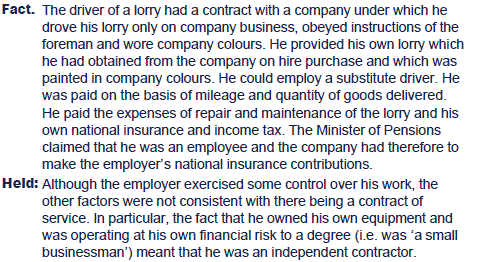

 Control test
Control test
An example of this test in operation may be seen in Walker v Crystal Palace Football Club (1910) in which it was decided that a professional footballer was an employee of his club on the basis that he was subject to control in relation to his training, discipline and method of pay.
However, with developing technology and specialisation, the control test became inappropriate as employers would hire people for particular skills (e.g. a chemical engineer), of which the employer did not have sufficient knowledge or skill to instruct as to the manner in which they carried out their work.
Integration test
An example of the application of the integration test may be seen in Whittaker v Minister of Pensions & National Insurance (1966) in which the court found that the degree to which a circus trapeze artist was required to do other general tasks in relation to the operation of the circus in which she appeared, indicated that she was an employee rather than self-employed. As a consequence, she was entitled to claim compensation for injuries sustained in the course of her employment.
The economic reality test
Market Investigations Ltd v Minister of Social Security (1968)
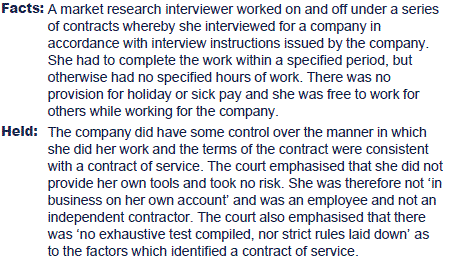
Temporary or casual workers
There are real problems in determining the status of temporary or casual workers.
O'Kelly v Trusthouse Forte Plc (1983)
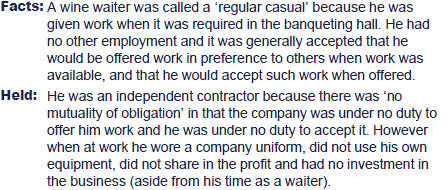
Home workers or outworkers
There are also problems with home workers or outworkers. Generally such people will be paid by the number of pieces they produce and will supply their own equipment. Their position is ambiguous and many consider themselves to be self-employed, but the law does not always take this view.
Nethermere (St Neots) Ltd v Taverna and Gardiner (1984)
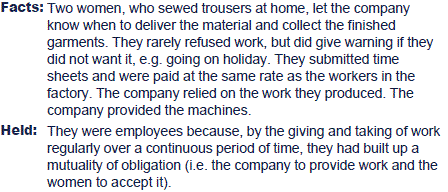

The importance of the distinction
The type of working relationship has a number of consequences:
- employees receive statutory protection (e.g. unfair dismissal/redundancy)
- there are implied terms in a contract of employment (e.g. duty of obedience)
- an employer is vicariously liable for the acts of employees when they act in the course of the employer's business. The employer is not liable for the acts of independent contractors
- on the insolvency of the employer, an employee is a preferential creditor, whereas someone who is self-employed ranks as an ordinary unsecured creditor
- employees receive their pay net of income tax and national insurance under the PAYE system. Independent contractors are taxed under the trading income provisions
- certain state benefits (e.g. statutory sick pay) are only available to employees.

 Test your understanding 1
Test your understanding 1
(1)Which of the following statements suggest that John is an independent contractor in relation to the work he carries out for Zed Ltd?
IHe is required to provide his own tools.
II He is required to carry out his work personally and is not free to send a substitute.
IIIHe is paid in full without any deduction of income tax.
A(I) and (II) only.
B(II) and (III) only.
C(I) and (III) only.
D(I), (II) and (III).
(2)H plc carries on its business using both employees and independent contractors. It is important for H plc to be able to distinguish between its employees and independent contractors for a number of reasons.
Which one of the following is incorrect?
AEmployees have a right not to be unfairly dismissed, but this does not apply to independent contractors.
BH plc must deduct income tax and national insurance contributions from the wages paid to its employees, but not from the amount paid to independent contractors.
CBoth employees and independent contractors can enforce contractual rights against H plc.
DBoth employees and independent contractors would rank as preferential creditors in respect of unpaid wages, if H plc went into insolvent liquidation.
(3)Which of the following is a test to determine a worker's status?
AThe neighbour test.
BThe multiple test.
CThe reasonableness test.
DThe test of remoteness.
(4)Which of the following statements is correct?
I An employer is vicariously liable for the torts of employees committed in the course of their employment.
II An employer is vicariously liable for the torts of independent contractors, if they were committed whilst carrying out work for the employer.
A(I) only.
B(II) only.
CBoth (I) and (II).
DNeither (I) nor (II).

2 The contract of employment
Contents
A contract of employment will consist of:
- express terms
- terms implied by the courts
- terms implied by statute.
Express terms
Express terms are those agreed by the parties themselves. The agreement may be written or oral.
The Employment Rights Act 1996 (ERA 1996) requires an employer to provide an employee with a written statement of certain particulars of their employment within two months of the commencement of employment.
The statement must include details of:
- pay rates and interval (i.e. weekly, monthly, etc.)
- job title
- hours of work
- place of work
- length of notice
- details of disciplinary and grievance procedures
- date of commencement of employment.
Any change must be notified by written statement within one month.
The statement is not a contract unless both parties agree and it is called a contract. It is strong prima facie evidence of the terms of the contract, but is not conclusive.
Terms implied by the courts
The courts have implied various duties into the employment contract.
Duties of the employee
Duty to obey lawful and reasonable orders
Pepper v Webb (1968)

Duty of mutual co-operation (or the duty to perform the work in a reasonable manner)
The duty of the employer to give, and the employee to obey, lawful instructions is often expressed as the duty of mutual co-operation. The courts have begun to imply a term that the employer must not act in a manner calculated to damage the mutual trust and confidence and this is taken into account in considering the reasonableness of the order. The courts have interpreted the duty to obey lawful and reasonable orders as a duty not to frustrate the commercial objectives of the employer.
Secretary of State for Employment v ASLEF (1972)

Duty to exercise reasonable care and skill
The employee must act with reasonable care in performing his duties. The standard of care will depend on the circumstances. It is generally accepted that a single act of negligence, unless it is gross negligence, will not justify summary dismissal. There are certain occupations, such as airline pilots, where a single act of negligence in performing essential duties may warrant dismissal.
An extension of this duty of care is a duty to indemnify the employer for any damages which he has had to pay as a result of his vicarious liability for the employee's negligence.
Lister v Romford Ice & Cold Storage Ltd (1972)

Duty of good faith – a duty to give honest and faithful service
The employee cannot use the employer's property as his own, and must account to his employer for any money or property which he receives in the course of his employment.
Sinclair v Neighbour (1967)

The employee may do other work in his own time. However, the law imposes a duty not to do spare time work which competes with that of his employer and may cause his employer damage.
An employee must not disclose trade secrets to a third party nor misuse confidential information he has acquired in the course of his employment. This implied duty may continue after the employment has ceased. Clearly an employee who uses or sells secret processes, such as chemical formulae, or photocopies list of customers and sells them or uses them for his own purposes will be in breach.
The real problem arises in drawing a line between trade secrets/confidential information and general knowledge and skill acquired by the employee in the course of his employment. An employee may always use skills he has learnt in his employment.
Hivac Ltd v Park Royal Scientific Instruments Ltd (1946)

Duty to render personal service
Employees may not delegate the performance of their work to someone else unless they have their employer's express or implied permission to do so.
Duties of the employer
Duty to pay reasonable remuneration
This will be implied in the absence of an express provision regarding pay.
Duty to indemnify the employee
The employer must indemnify his employee where the employee has incurred a legal liability or necessary expenses whilst acting on the employer's behalf.
Duty to provide a safe system of work
At common law the employer is under a duty to take reasonable care for the health and safety of his employees. Breach of this duty exposes the employer to liability in negligence to his employees.
In addition, the employer is under various statutory duties, e.g. the Factories Act 1961, the Offices, Shops and Railway Premises Act 1963, and the Health and Safety at Work etc. Act 1974 all regulate work conditions.
The requirement at common law is to take reasonable care to provide a safe system of work and this encompasses such matters as the selection of staff and provision for their supervision; and ensuring that premises, plant and materials are safe.
In assessing the reasonableness of the employer in these matters a number of factors must be considered. For example: what was the risk of injury? What was the cost of prevention? What were the characteristics of the employee?
If the employer has not acted unreasonably, he has not been negligent, and has no common law liability.
Latimer v AEC Ltd (1953)

Duty to give reasonable notice of termination of employment
In practice this implied duty rarely arises since most contracts of employment contain express provision stating the exact length of notice or stating that the contract is to be for a fixed term. Also there are statutory minimum periods of notice.
Duty of mutual co-operation
This duty has already been discussed in respect of employees' duties. The employer has a duty not to behave in a manner calculated to damage the relationship of trust and confidence, e.g. by abusively reprimanding an employee.
Provision of work
There is no general common law duty to provide work. However, such a term may be implied, under the business efficacy test, where failure to provide work would deprive the employee of a benefit contemplated by the contract. For example, if the contract expressly provides for remuneration on a piecework or commission basis it may be possible to imply a duty on the employer to provide sufficient work to enable the employee to earn a reasonable sum.
Similarly, where the employee is skilled and needs practice to maintain those skills, there may be an obligation to provide a reasonable amount of work.
William Hill Organisation Ltd v Tucker (1998)

Provision of a reference
There is no duty to provide a reference but, if one is provided, it must be truthful, as shown in:
Spring v Guardian Assurance (1994)
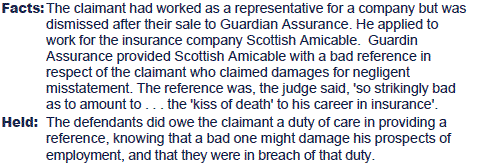
Terms implied by statute
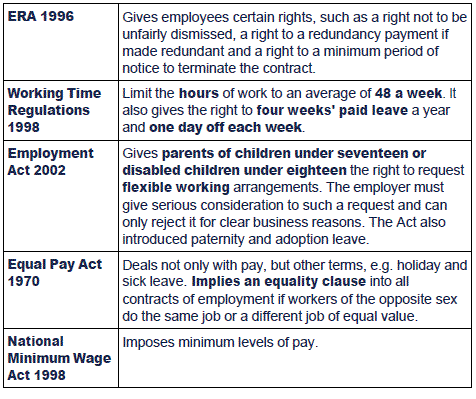

 Test your understanding 2
Test your understanding 2
(1)Which one of the following is normally implied into a contract of employment?
AA duty to provide a reference.
BA duty to provide work.
CA duty to pay reasonable remuneration.
DAn employee's duty to disclose his own misconduct.
(2)Which one of the following statements is correct?
AAn employer is obliged to provide a careful and honest reference.
BAn employer is obliged to provide a safe system of work.
CAn employer is obliged to provide employees with smoking facilities during authorised breaks at work.
DAn employer is obliged to give two days off a week.
(3)Which of the following are sources of terms of a contract of employment?
ICustom and practice.
II A collective agreement between the union and the employer.
A(I) only.
B(II) only.
CBoth (I) and (II).
DNeither (I) nor (II).
(4)An employer must provide an employee with a written statement of particulars of the employment:
AWithin one month of the employment commencing
BAs soon after the commencement of employment as possible
CWithin two months of the employment commencing.
DWithin a reasonable time of the employment commencing
(5)Which of the following statements are correct with regard to the terms of the Employment Act 2002?
IParents of children under six years old have the right to request a flexible working arrangement.
II An employer receiving a request from an employee for a flexible working arrangement, in accordance with the Act, is obliged to offer such an arrangement.
A(I) only.
BBoth (I) and (II).
C(II) only.
DNeither (I) nor (II).


 Test your understanding 3
Test your understanding 3
Eric and Freda have worked together as partners for many years. They have decided to take on staff in order to expand the business. They are unsure as to what rights and obligations this will entail.
AFill in the gaps.
The choice of status of worker is between that of an ................................................ and an ........................................................... These are distinguished mostly by the use of the .................................................... test. Three of the factors in determining that a worker is an ....................................... are:
BFill in the gaps.
Under the ……………………… a ……………must be given to employees within two months of starting work. That statement must be in writing/can be oral and these are three examples of what it must contain:
CState the main common law duties owed by an employee to employer

3 Wrongful and unfair dismissal
Minimum notice periods
If a period of notice is not expressly agreed, the ERA 1996 imposes the following minimum notice periods:
Notice by employer

Notice by employee
An employee with at least four weeks' continuous employment must give his employer at least one week's notice of his terminating of the contract.
Wrongful dismissal
A claim for wrongful dismissal is a common law action for breach of contract. The claim is available to both employees and independent contractors. The usual rules of breach of contract will apply.
 Wrongful dismissal occurs where the employer terminates the contract:
Wrongful dismissal occurs where the employer terminates the contract:
- without giving proper notice or
- during its fixed term.
 Dismissal without notice is known as summary dismissal.
Dismissal without notice is known as summary dismissal.
Summary dismissal is usually wrongful dismissal unless the employee:
- waives their rights or accepts payment in lieu of notice
- repudiates the contract themselves or is in fundamental breach (e.g. wilful refusal to obey orders; failure to show professed skill; serious negligence; breach of duty of good faith).
Remedies
An individual who believes he has been wrongfully dismissed may sue in the County court or High Court for damages. The limitation period for such a claim is six years.
Alternatively, if he is an employee, he can bring a claim to the employment tribunal provided he does so within three months of his dismissal and the claim is for £25,000 or less.

 Test your understanding 4
Test your understanding 4
Mario is entitled to one month's notice. Consider both of the following situations and state whether he has been wrongfully dismissed:
AThe employer dismisses Mario on one month’s notice, but gives him no reason for the dismissal.
BThe employer dismisses Mario without notice for fighting in the workplace with another employee.

Unfair dismissal
This is a statutory right under the Employment Rights Act 1996. Only employees can bring an action for unfair dismissal.
 The employer terminates the contract without justifiable reason.
The employer terminates the contract without justifiable reason.
Types of dismissal
- Contract terminated by employer with or without notice.
- Fixed-term contract expired and not renewed.
- Constructive dismissal.
Constructive dismissal
Normally employees who resign deprive themselves of the right to make a claim for redundancy or unfair dismissal. However, s95 ERA 1996 covers situations where 'the employee terminates the contract with, or without, notice in circumstances which are such that he or she is entitled to terminate it without notice by reason of the employer's conduct'. This is known as constructive dismissal.
In Western Excavating (ECC) Ltd v Sharp (1978) it was held that an employee is entitled to treat himself as constructively dismissed if the employer is guilty of conduct which is a significant breach going to the root of the contract of employment, or which shows that the employer no longer intends to be bound by one or more of the essential terms of the contract. Whether the employee leaves with or without notice, the conduct must be sufficiently serious to entitle him to leave at once. However, he must act quickly, for if he continues for any length of time without leaving, he will be regarded as having elected to affirm the contract and will lose his right to treat himself as discharged.
Where such a repudiatory breach occurs the employee resigns and will have an action against the employer for wrongful dismissal.
Donovan v Invicta Airways (1970)

Simmonds v Dowty Seals Ltd (1978)

Kevin Keegan v Newcastle United Football Club Limited (2010)

In British Aircraft Corporation v Austin (1978) a failure to investigate a health and safety complaint was held to be conduct sufficient to entitle the employee to treat the contract as terminated.
If the employee does not resign in the event of the breach, he is deemed to have accepted the breach and waived any rights. However, he need not resign immediately and may legitimately wait until he has found another job: Cox Toner (International) Ltd v Crook (1981).
Statutory fair reasons for dismissal
Dismissal for one of the following reasons is fair unless the employer acted unreasonably in dismissing for the reason given:
- capabilities/qualifications of employee
- conduct of employee
- redundancy (see below)
- retirement (see below)
- continued employment would contravene statute
- some other substantial reason.
Reasons for dismissal
An employer can only rely on a given reason for dismissal where he knew of it at the date of the dismissal.
Devis W & Sons Ltd v Atkins (1977)

Stevenson v Golden Wonder Ltd (1977)

An example of 'some other substantial reason' justifying dismissal is the case of Singh v London Country Bus Services (1976), where an employee in a position of trust was convicted of a criminal offence of dishonesty (which he committed off duty).
Reasonableness of employer
Once the employee has shown they were dismissed and the employer has shown that it was for one or more of the six fair reasons it is then for the tribunal to decide whether the dismissal was fair or unfair.
S98(4) ERA 1996 states that the determination of this question 'depends on whether in the circumstances (including the size and administrative resources of the employer's undertaking) the employer acted reasonably or unreasonably in treating it (the reason) as a sufficient reason for dismissing the employee'. The question 'shall be determined in accordance with equity and the substantial merits of the case'.
Case law shows that this 'reasonableness test' involves two questions:
- Whether the reason given was sufficiently serious to justify dismissal.
- Whether the employer adopted reasonable procedures both in coming to the decision to dismiss and in the manner of the dismissal.
The Arbitration, Conciliation and Advisory Service (ACAS) has issued codes of practice for procedures to be followed in coming to the decision to dismiss an employee (e.g. warnings, proper inquiry into alleged misconduct, etc.) which the employment tribunal has regard to. These were illustrated by the House of Lords in Polkey v Dayton (AE) Services (1987) where it was stated that:
- in a case of incapability, the employer will normally not act reasonably unless he gives the employee fair warning and an opportunity to mend his ways and show he can do the job
- in a case of misconduct, the employer will normally not act reasonably unless he investigates the complaint fully and fairly and hears whatever the employee wishes to say in his defence or in explanation or mitigation
- in a case of redundancy (this was the situation in Polkey) the employer will normally not act reasonably unless he warns and consults any employees affected or their representative, adopts a fair basis upon which to select for redundancy and takes such steps as may be reasonable to avoid or minimise redundancy by redeployment within his own organisation.
Inadmissible reasons for dismissal
Dismissal for one of the following reasons is automatically unfair. This means that there is no need to meet the length of employment condition. The tribunal will also make an additional award of compensation.
The inadmissible reasons are:
- victimisation of health and safety complainants or whistleblowers. A whistleblower is a person who raises a concern about wrongdoing occurring in an organisation. The revealed misconduct may be classified in many ways; for example, a violation of a law, rule, regulation and/or a direct threat to public interest, such as fraud, health/safety violations, and corruption
- pregnancy or the exercise of maternity leave rights
- trade union membership/non-membership/activities
- assertion of a statutory right e.g. the exercise of paternity leave rights
- unfair selection for redundancy (see section 4).
Retirement
Dismissal on the ground of retirement is fair provided:
- it takes effect on or after the default retirement age of 65 (or on or after the employer's normal retirement age, if there is one); and
- the employer has given the employee written notice of the date of their intended retirement at least six months in advance and told them about their right to request to continue working.
If the employer fails to give six months' notice of the intended retirement date, they may be required to pay compensation for the late notification. If the notification is made within the two weeks prior to the intended retirement date, the dismissal will be automatically unfair.
If the employee wishes to continue working, they must make their request in writing at least three months before the proposed retirement date. Their request must be considered before the employee is retired. Failure to do so will make the dismissal automatically unfair.
Note that although the employer is required to consider any request to work after the normal retirement age, they are entitled to refuse the request. As long as the employer has followed the proper procedure, they may dismiss on the ground of retirement without the dismissal being regarded as unfair or age discriminatory.
Remedies for unfair dismissal
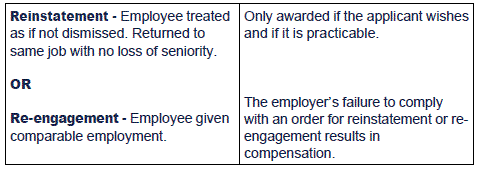


 Test your understanding 5
Test your understanding 5
You have recently been appointed personnel director of a major plc. The board has asked for a review and report on various employment law issues relevant to the employees and working practices within the firm. You investigate the relevant areas of law discussed below.
AFill in the gaps.
The ………………………..sets out a number of reasons why a dismissal will be ………………………..unfair.
The five major reasons are:
I.
II.
III.
IV.
BExplain the remedies for unfair dismissal available to a tribunal.

4 Redundancy
 An employee is redundant if his dismissal is wholly or mainly attributable to the fact that:
An employee is redundant if his dismissal is wholly or mainly attributable to the fact that:
- the employer has ceased, or intends to cease, business for the purposes for which the employee has been employed
- the employer has ceased, or intends to cease to carry on the business in the place where the employee was employed, or
- the requirements of that business for employees to carry out work of a particular kind, or for them to carry out the work in the place where they were so employed, have ceased or diminished.
Note that the work may have ceased altogether or only in the place where the employee was employed.
Redundancy consultation process
If you fail to consult employees - and their representatives if applicable - in a redundancy situation, the redundancy dismissals will almost certainly be unfair.
If you plan to make 20 or more employees redundant in one place of work within a 90-day period, known as a collective redundancy situation, you must:
- Notify the Department for Business, Innovation & Skills; and
- Consult with workplace representatives. These may be either trade union representatives or, where no union is recognised, elected employee representatives instead. If your employees choose not to elect employee representatives, you must give the relevant information directly to each individual.
Consultation must start in good time - when redundancy proposals are in their formative stage - and at least:
- 30 days before the first redundancy where there are 20 to 99 proposed redundancies
- 90 days in advance where there are 100 or more proposed redundancies.
Procedure:

 Expandable text
Expandable text
Is the employee redundant?
European Chefs Catering v Currell (1971)

Vaux and Associated Breweries v Ward (1969)

The place where a person is employed means in this context the place where he is habitually employed and any place where, under his contract, he can be required to work. There will not, therefore, be a redundancy situation where the transfer of location is reasonable or where the contract gives the employer an express or implied right to move (a mobility clause may have been agreed in the contract) the employee in question from one place to another. This is not the case, though, if the employer has no such right: O'Brien v Associated Fire Alarms (1969).

Redundancy pay
Redundancy pay is calculated in the same way as the basic award for unfair dismissal.
However, an employee is not entitled to redundancy pay if they unreasonably refuse an offer of fresh employment (made before the old contract expires) to start within four weeks on the same or suitable terms. The employee must be allowed at least a four-week trial period in the new job.
Whether the alternative employment offered is suitable, or the offer was unreasonably refused, are both questions of fact to be determined by reference to such matters as the employee's skill and working conditions, the requirements of his family, change in earnings, age, health, sex, etc. Any dispute arising in this respect is for the tribunal to determine and the onus of proof is on the employer.
Taylor v Kent County Council (1969)

5 Chapter summary
Test your understanding answers

 Test your understanding 1
Test your understanding 1
(1)C
Independent contractors would have their own tools, and would be paid in full for their work without deduction of income tax. They may do the work personally; alternatively, they may send a substitute. Items (i) and (iii) therefore apply, but not (ii).
(2)D
On a company being wound up, arrears of wages due to employees for four months up to the commencement of the winding up rank as preferential debts. Arrears of money owing to independent contractors do not rank as preferential debts.
(3)B
The multiple test is one of the tests used to determine a worker's status. It is sometimes called the economic reality test.
(4)A
An employer is vicariously liable for the torts of employees whilst they are at work, but is not liable for the torts of any independent contractor providing services to the employer.


 Test your understanding 2
Test your understanding 2
(1)C
A duty to pay reasonable remuneration is normally implied in a contract of employment.
(2)B
An employer does not have to provide a reference for an employee leaving to work somewhere else. Nor does an employer have to provide smoking facilities at work – you might have seen employees standing outside their place of work, smoking in the street, because there is nowhere on the premises to smoke. An employer is obliged to give only one day off a week. However, an employer is under an obligation to provide a safe system of work.
(3)C
The terms of a contract of employment might be subject to a collective agreement between an employer and a trade union, so (ii) is quite clearly correct. In addition, some terms of employment might be derived from custom and practice.
(4)C
A written statement must be provided within two months of commencement.
(5)A
The right of a parent to ask for a flexible working arrangement applies to parents of children under six and disabled children under 18. Statement (i) is correct. An employer is obliged to consider such requests seriously, but may refuse where there is a clear business reason. Statement (ii) is therefore incorrect.


 Test your understanding 3
Test your understanding 3
AEmployee
independent contractor
multiple/economic reality
employee
Any three of the following:
- control
- provision of his own equipment
- whether he hires his own helpers
- the degree of financial risk he undertakes
- the degree of responsibility he bears for investment and management
- the extent to which he has an opportunity of profiting from sound management in the performance of his task
- whether there is a regular method of payment
- whether the person works regular hours
- whether there is mutuality of obligations.
BEmployment Rights Act 1996
Statement of Particulars
Must be in writing
Any three of the following:
- how pay will be calculated and paid
- job title and nature of the work
- date on which employment began
- intervals of pay
- hours of work
- holidays and holiday pay
- sick pay/leave
- pension scheme details
- place of work
- any collective agreement
- length of notice required
- names of employer and employee.
CDuties to obey lawful reasonable orders, of mutual co-operation (care and skill), of good faith and of personal service.


 Test your understanding 4
Test your understanding 4
AMario has not been wrongfully dismissed as he has been given the appropriate amount of notice.
BMario has not been wrongfully dismissed as his conduct puts him in serious breach of his contract.


 Test your understanding 5
Test your understanding 5
AEmployment Rights Act 1996
automatically
Icomplaints/actions by an employee under the Health and Safety at Work etc. Act 1974
II Pregnancy or childbirth
IIITrade union related activities
IVAssertion of statutory right
V Unfair selection for redundancy
BA complainant can be compensated, re-instated under the same contract or re-engaged under a different contract in the same organisation.

|
Created at 5/24/2012 3:09 PM by System Account
(GMT) Greenwich Mean Time : Dublin, Edinburgh, Lisbon, London
|
Last modified at 8/20/2012 5:50 PM by System Account
(GMT) Greenwich Mean Time : Dublin, Edinburgh, Lisbon, London
|
|
|
|
 |
Rating
:
|
 Ratings & Comments
(Click the stars to rate the page) Ratings & Comments
(Click the stars to rate the page)
|
 |
Tags:
|
|
|
|
|